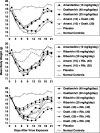Effects of double combinations of amantadine, oseltamivir, and ribavirin on influenza A (H5N1) virus infections in cell culture and in mice
- PMID: 19273672
- PMCID: PMC2681546
- DOI: 10.1128/AAC.01012-08
Effects of double combinations of amantadine, oseltamivir, and ribavirin on influenza A (H5N1) virus infections in cell culture and in mice
Abstract
An amantadine-resistant influenza A/Duck/MN/1525/81 (H5N1) virus was developed from the low-pathogenic North American wild-type (amantadine-sensitive) virus for studying treatment of infections in cell culture and in mice. Double combinations of amantadine, oseltamivir (or the cell culture-active form, oseltamivir carboxylate), and ribavirin were used. Amantadine-oseltamivir carboxylate and amantadine-ribavirin combinations showed synergistic interactions over a range of doses against wild-type virus in Madin-Darby canine kidney (MDCK) cell culture, but oseltamivir carboxylate-ribavirin combinations did not. Primarily additive interactions were seen with oseltamivir carboxylate-ribavirin combinations against amantadine-resistant virus. The presence of amantadine in drug combinations against the resistant virus did not improve activity. The wild-type and amantadine-resistant viruses were lethal to mice by intranasal instillation. The resistant virus infection could not be treated with amantadine up to 100 mg/kg body weight/day, whereas the wild-type virus infection was treatable with oral doses of 10 (weakly effective) to 100 mg/kg/day administered twice a day for 5 days starting 4 h prior to virus exposure. Drug combination studies showed that treatment of the amantadine-resistant virus infection with amantadine-oseltamivir or amantadine-ribavirin combinations was not significantly better than using oseltamivir or ribavirin alone. In contrast, the oseltamivir-ribavirin (25- and 75-mg/kg/day combination) treatments produced significant reductions in mortality. The wild-type virus infection was markedly reduced in severity by all three combinations (amantadine, 10 mg/kg/day combined with the other compounds at 20 or 40 mg/kg/day) compared to monotherapy with the three compounds. Results indicate a lack of benefit of amantadine in combinations against amantadine-resistant virus, but positive benefits in combinations against amantadine-sensitive virus.
Figures



References
-
- Centers for Disease Control and Prevention. 2008. Interim within-season estimate of the effectiveness of trivalent inactivated influenza vaccine - Marshfield, Wisconsin, 2007-08 influenza season. MMWR Morb. Mortal. Wkly. Rep. 57:393-398. - PubMed
-
- Cheung, C. L., J. M. Rayner, G. J. Smith, P. Wang, T. S. Naipospos, J. Zhang, K. Y. Yuen, R. G. Webster, J. S. Peiris, Y. Guan, and H. Chen. 2006. Distribution of amantadine-resistant H5N1 avian influenza variants in Asia. J. Infect. Dis. 193:1626-1629. - PubMed
-
- Crusat, M., and M. D. de Jong. 2007. Neuraminidase inhibitors and their role in avian and pandemic influenza. Antivir. Ther. 12:593-602. - PubMed
-
- de Jong, M. D., T. T. Tran, H. K. Truong, M. H. Vo, G. J. Smith, V. C. Nguyen, V. C. Bach, T. Q. Phan, Q. H. Do, Y. Guan, J. S. Peiris, T. H. Tran, and J. Farrar. 2005. Oseltamivir resistance during treatment of influenza A (H5N1) infection. N. Engl. J. Med. 353:2667-2672. - PubMed
Publication types
MeSH terms
Substances
Grants and funding
LinkOut - more resources
Full Text Sources
Other Literature Sources
Medical

